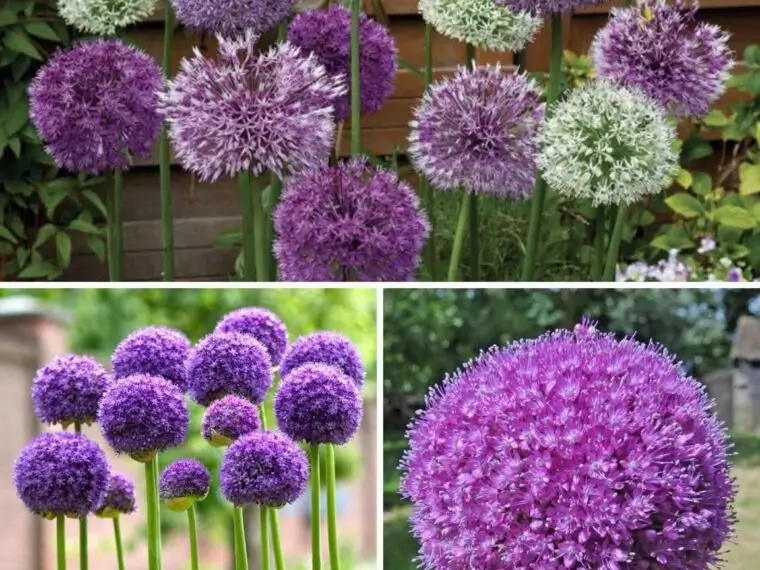How to Plant Allium
Alliums are grown from bulbs, much like tulips and daffodils. They thrive best when planted in the fall before the first frost, allowing the bulbs to establish strong roots before winter.
Step 1: Choose the Right Location
- Sunlight: Alliums need full sun to thrive, requiring at least 6 hours of direct sunlight per day.
- Soil: They prefer well-draining soil that is not prone to waterlogging. Sandy or loamy soils are ideal.
- Spacing: Space bulbs 6-12 inches apart depending on the variety to allow room for growth.
Step 2: Prepare the Soil
- Loosen the soil to a depth of 8-12 inches and remove any weeds or rocks.
- Mix in organic compost or aged manure to improve drainage and nutrient content.
- Avoid heavy clay soils, which can retain too much moisture and cause bulb rot.
Step 3: Planting the Bulbs
- Plant allium bulbs 2-3 times deeper than their height (typically 4-6 inches deep).
- Place the pointed end facing upward.
- Cover the bulbs with soil and water lightly to settle them in place.
Step 4: Mulching
- Apply a thin layer of mulch (straw, bark, or shredded leaves) to help retain moisture and suppress weeds.
- Avoid excessive mulching, as alliums prefer drier conditions.
How to Care for Alliums
1. Watering Needs
- Alliums are drought-tolerant once established and require minimal watering.
- Water only when the soil is dry to the touch, as too much moisture can lead to root rot.
2. Fertilizing
- Apply a balanced, slow-release fertilizer in early spring to promote healthy growth.
- For optimal blooms, use a phosphorus-rich fertilizer to encourage flower production.
- Avoid excessive nitrogen, which promotes leafy growth over flowers.
3. Pruning and Deadheading
- Once flowers fade, you can deadhead them to maintain a tidy appearance, but leave the foliage until it turns yellow.
- Do not cut back the green leaves immediately after blooming, as they continue to photosynthesize and strengthen the bulb for the next season.
- If you enjoy the look of dried seed heads, leave them in place for added texture in the garden.
4. Dividing and Propagating
- Alliums multiply over time, forming clumps of bulbs.
- Every 3-5 years, dig up and separate bulbs in late summer or early fall to prevent overcrowding.
- Replant bulbs immediately, following the same depth and spacing recommendations.
5. Overwintering
- Alliums are winter-hardy in most climates (USDA zones 3-9).
- In extremely cold regions, apply a light layer of mulch for insulation.
- If grown in containers, move pots to a protected area to prevent freezing.
Common Pests and Problems
While alliums are generally low-maintenance and resistant to deer and rodents, they may still encounter a few issues:
1. Bulb Rot
- Cause: Overwatering or poor drainage.
- Solution: Ensure well-draining soil and avoid excessive watering.
2. Onion Thrips
- Cause: Tiny pests that suck sap from the plant, causing yellowing leaves.
- Solution: Spray plants with neem oil or insecticidal soap.
3. Fungal Diseases (Downy Mildew, Rust)
- Cause: High humidity and poor air circulation.
- Solution: Space plants properly and avoid overhead watering.
4. Weak or No Blooms
- Cause: Poor soil, insufficient sunlight, or overcrowding.
- Solution: Amend the soil, ensure proper sun exposure, and divide bulbs when necessary.
Companion Planting with Alliums
Alliums make excellent companion plants due to their pest-repelling properties. Consider planting them with:
- Roses – Alliums help deter aphids and enhance visual contrast.
- Tomatoes & Peppers – Repels pests like aphids and spider mites.
- Carrots & Beets – Helps reduce the risk of root maggots.
- Lavender & Salvia – Complements allium’s architectural beauty in flower beds.
Avoid planting alliums near beans or peas, as their strong scent may hinder growth.
Using Alliums in Garden Design
Alliums create a bold statement in the garden. Here’s how to use them effectively:
- Borders & Pathways: Plant in rows or clusters for a structured look.
- Wildflower Gardens: Mix with perennials like echinacea and rudbeckia.
- Container Gardens: Use dwarf varieties like Allium ‘Moly’ for patio containers.
- Cut Flower Arrangements: Alliums make stunning dried and fresh floral displays.
Alliums are a must-have for any gardener looking for a low-maintenance, high-impact perennial.
Their striking spherical blooms, resistance to pests, and ability to attract pollinators make them a standout choice for flower beds, borders, and containers.
By following these growing and care tips, you can ensure a vibrant and healthy allium display year after year.
